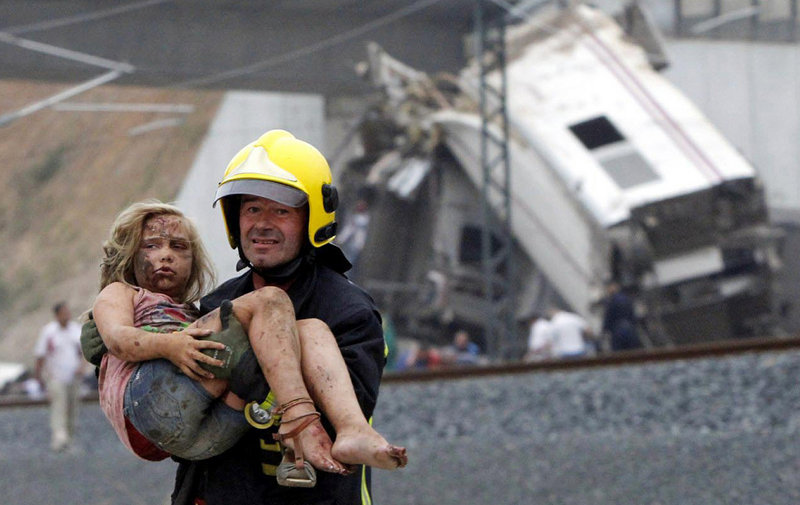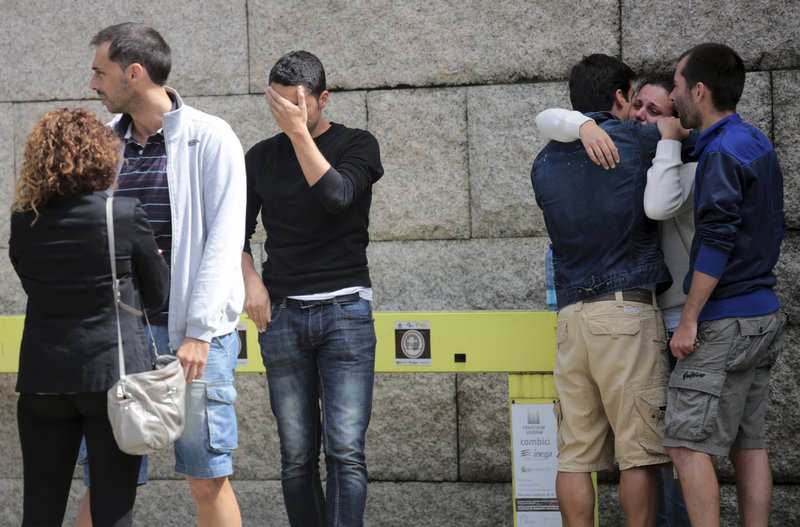SANTIAGO DE COMPOSTELA, Spain – The Spanish train that hurtled off the rails and smashed into a security wall was going so fast that carriages tumbled off the tracks like dominos, according to eyewitness accounts and video footage obtained Thursday.
By late Thursday, 80 people had died and more than 90 were hospitalized, with 31 in critical condition.
An Associated Press analysis of video images suggests the train may have been traveling at twice the speed limit, or more, along that curved stretch of track. The unanswered question is: Why?
Spain’s government said two investigations have been launched into the train’s derailment Wednesday night on its approach to this Christian festival city in northwest Spain, where planned celebrations in honor of one of Jesus’ disciples gave way to a living nightmare.
VIDEO INDICATES HIGH SPEED
The regional government in Galicia confirmed that police planned to question the 52-year-old train driver — who is in Santiago de Compostela’s main hospital with unspecified injuries — as both a witness and as a possible suspect, but cautioned that possible faults in safety equipment were also being examined.
The U.S. State Department said one American was killed in the crash and five others were injured.
Thursday morning, Prime Minister Mariano Rajoy toured the crash scene alongside rescue workers and went to a nearby hospital to visit those wounded and their families. In the evening, Spain’s head of state, King Carlos, and Queen Sofia went to the same hospital, dressed in funereal black.
“For a native of Santiago, like me, this is the saddest day,” said Rajoy, who declared Spain would observe a three-day period of mourning. He said judicial authorities and the Public Works Ministry had launched parallel investigations into what caused the crash.
Eyewitness accounts backed by security-camera footage of the moment of disaster suggested that the eight-carriage train was going too fast as it tried to turn left underneath a road bridge. The train company Renfe said 218 passengers and five crew members were on board. Spanish officials said the speed limit on that section of track is 50 miles per hour.
An Associated Press estimate of the train’s speed at the moment of impact using the time stamp of the video and the estimated distance between two pylons gives a range of 89-119 mph. Another estimate calculated on the basis of the typical distance between railroad ties gives a range of 96-112 mph.
The video footage, which the Spanish railway authority Adif said probably came from one of its cameras, shows the train carriages starting to buckle soon into the turn.
Murray Hughes, consultant editor of Railway Gazette International, said it appeared that a diesel-powered unit behind the lead locomotive was the first to derail. The front engine itself quickly followed, violently tipping on to its right side as it crashed into a concrete security wall and bulldozed along the ground.
In the background, all the rear carriages could be seen starting to decouple and come off the tracks. The picture went blank as the engine appeared to crash directly into the camera.
After impact, witnesses said a fire engulfed passengers trapped in at least one carriage, most likely driven by ruptured tanks of diesel fuel carried in the forward engines.
“I saw the train coming out of the bend at great speed and then there was a big noise,” one eyewitness who lives beside the train line, Consuelo Domingues, told The Associated Press. “Then everybody tried to get out of the train.”
Santiago officials had been preparing for the city’s internationally celebrated Catholic festival Thursday, but canceled it and took control of the city’s main indoor sports arena to use as a makeshift morgue. There, relatives of the dead could be seen sobbing and embracing each other.
The Interior Ministry, responsible for law and order, ruled out terrorism as a cause.
While sections of the Spanish press pointed an accusatory finger at the train driver, Spanish authorities and railway safety experts cautioned that a fault in systems designed to keep trains traveling at safe speeds could be to blame.
TRAIN HAD EXPERIENCED DRIVER
Spain’s lead investigator in the crash, Judge Vazquez Ta? ordered detectives to question the train driver.
Renfe described the driver, Francisco Jose Garzon Amo, as a 30-year employee of the state rail company who became an assistant driver in 2000 and a fully qualified driver in 2003. The company said Amo took control of the train from a second driver about 65 miles south of Santiago de Compostela.
Renfe’s president, Julio Gomez-Pomar Rodriguez, president of Renfe, told Spain’s Cadena Cope radio network that the driver had worked on that route for more than one year.
It was Spain’s deadliest train accident since 1972, when a train collided with a bus in southwest Spain, killing 86 people and injuring 112.
Send questions/comments to the editors.




Success. Please wait for the page to reload. If the page does not reload within 5 seconds, please refresh the page.
Enter your email and password to access comments.
Hi, to comment on stories you must . This profile is in addition to your subscription and website login.
Already have a commenting profile? .
Invalid username/password.
Please check your email to confirm and complete your registration.
Only subscribers are eligible to post comments. Please subscribe or login first for digital access. Here’s why.
Use the form below to reset your password. When you've submitted your account email, we will send an email with a reset code.